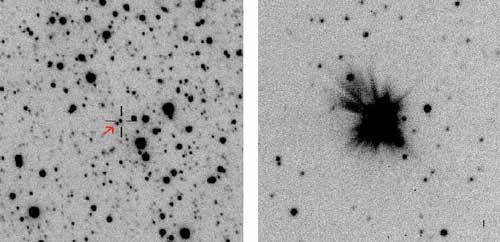| Oct 11, 2017 |
Scientists discover one of the most luminous 'new stars' ever
|
|
(Nanowerk News) Astronomers have today announced (Monthly Notices of the Royal Astronomical Society, "Multiwavelength observations of nova SMCN 2016-10a - Probably the brightest nova in the SMC and one of the brightest on record") that they have discovered possibly the most luminous 'new star' ever - a nova discovered in the direction of one of our closest neighboring galaxies: The Small Magellanic Cloud.
|
 |
| Left: the nova system before eruption. Right: the nova system in outburst. (Image: OGLE survey)
|
|
Astronomers from the University of Leicester contributed to the discovery by using the Swift satellite observatory to help understand what was likely the most luminous white dwarf eruption ever seen.
|
|
A nova happens when an old star erupts dramatically back to life. In a close binary star system consisting of a white dwarf and a Sun-like companion star, material is transferred from the companion to the white dwarf, gradually building up until it reaches a critical pressure. Then uncontrolled nuclear burning occurs, leading to a sudden and huge increase in brightness. It is called a nova because it appeared to be a new star to the ancients.
|
|
Novae are usually found in visible light, but often go on to emit higher energy X-rays as well. Together, these different datasets provide information on the white dwarf, such as its temperature and chemical composition.
|
|
Using telescopes from South Africa to Australia to South America, as well as the orbiting Swift observatory, a team led by the South African Astronomical Observatory has revealed that the nova SMCN 2016-10a, which was discovered on 14th October 2016, is the most luminous nova ever discovered in the SMC, and one of the brightest ever seen in any galaxy. The observations that they made are the most comprehensive ever for a nova in this galaxy.
|
|
The SMC, 200,000 light-years away, is one of our closest companion galaxies; it is a dwarf galaxy, very much less massive than our own. Novae occur frequently in our Galaxy, with a rate of around 35 each year, but SMCN 2016-10a is the first nova to have been detected in the SMC since 2012.
|
|
Dr Kim Page, a member of the Swift team at the University of Leicester, led the X-ray analysis, while Paul Kuin, from the Mullard Space Science Laboratory, University College London, organised the UV data.
|
|
Dr Page said: "Swift's ability to respond rapidly, together with its daily-planned schedule, makes it ideal for the follow-up of transients, including novae. It was able to observe the nova throughout its eruption, starting to collect very useful X-ray and UV data within a day of the outburst first being reported. The X-ray data were essential in showing that the mass of the white dwarf is close to the theoretical maximum; continued accretion might cause it eventually to be totally destroyed in a supernova explosion."
|
|
Dr Kuin added:"The present observations provide the kind of coverage in time and spectral colour that is needed to make progress for gaining understanding of a nova in a neighbouring galaxy. Observing the nova in different wavelengths using world-class telescopes such as Swift and the Southern African Large Telescope help us reveal the condition of matter in nova ejecta as if it were nearby."
|
|
Professor Julian Osborne, who leads the Swift team at the University of Leicester, and was also involved in this study, said: "Although it is difficult to measure the distance to novae directly, its position in the SMC on the sky, and everything else we know about this nova point to it being in this dwarf galaxy. This makes the nova as intrinsically bright as the most luminous ever seen, and thus very interesting in trying to understand these explosions."
|

